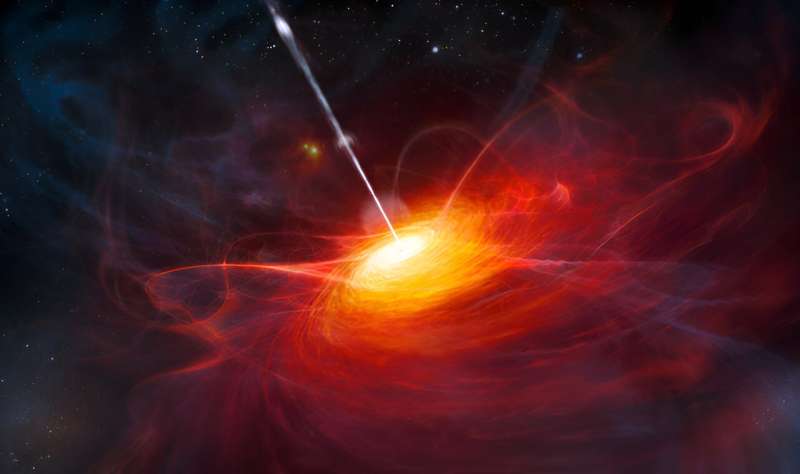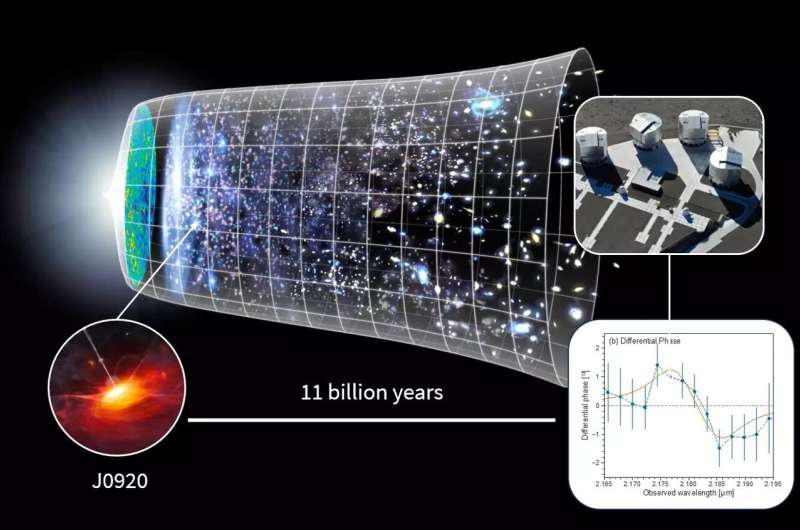This article has been reviewed according to Science X's editorial process and policies. Editors have highlighted the following attributes while ensuring the content's credibility:
fact-checked
peer-reviewed publication
trusted source
proofread
Black hole at the center of a galaxy in the early universe received less mass influx than expected, astronomers find

With the upgraded GRAVITY-instrument at the Very Large Telescope Interferometer of the European Southern Observatory, a team of astronomers led by the Max Planck Institute for Extraterrestrial Physics has determined the mass of a black hole in a galaxy only 2 billion years after the Big Bang. With 300 million solar masses, the black hole is actually under-massive compared to the mass of its host galaxy. Researchers suspect what is happening here.
A paper on this work is published in the journal Nature.
In the more local universe, astronomers have observed tight relationships between the properties of galaxies and the mass of the supermassive black holes residing at their centers, suggesting that galaxies and black holes co-evolve. A crucial test would be to probe this relationship at early cosmic times, but for these far-away galaxies, traditional direct methods of measuring the black hole mass are either impossible or extremely difficult.
Even though these galaxies often shine very brightly (they were dubbed "quasars" or "quasi-stellar objects" when they were first discovered in the 1950s), they are so far away that they cannot be resolved with most telescopes.
"In 2018, we did the first breakthrough measurements of a quasar's black hole mass with GRAVITY," says Taro Shimizu, staff scientist at the Max Planck Institute for Extraterrestrial Physics. "This quasar was very nearby, however. Now, we have pushed all the way out to a redshift of 2.3, corresponding to a lookback time of 11 billion years."

GRAVITY+ now opens a new and precise way to study black hole growth at this critical epoch, often called "cosmic noon," when both black holes and galaxies were rapidly growing.
"This is really the next revolution in astronomy—we can now get images of black holes in the early universe, 40 times sharper than possible with the James Webb telescope," points out Frank Eisenhauer, director at the Max Planck Institute for Extraterrestrial Physics, who leads the group developing the GRAVITY instrument and the GRAVITY+ improvements. GRAVITY combines all four 8-meter-telescopes of the ESO Very Large Telescope interferometrically, essentially creating one giant virtual telescope with a diameter of 130 meters.
The team was able to spatially resolve the motion of gas clouds around the central black hole of the galaxy, called SDSS J092034.17+065718.0, as they rotate in a thick disk. This allows a direct measurement of the mass of the black hole. With 320 million solar masses, the black hole mass turns out to be actually underweight compared to its host galaxy, which has a mass of about 60 billion solar masses. This suggests that the host galaxy grew faster than the supermassive black hole, indicating a delay between galaxy and black hole growth for some systems.
"The likely scenario for the evolution of this galaxy seems to be strong supernova feedback, where these stellar explosions expel gas from the central regions before it can reach the black hole at the galactic center," says Jinyi Shangguan, scientist in the same research group. "The black hole can only start to grow rapidly—and to catch up to the galaxy's growth overall—once the galaxy has become massive enough to retain a gas reservoir in its central regions even against supernova feedback."
To determine whether this scenario is also the dominant mode of the co-evolution for other galaxies and their central black holes, the team will follow up with more high-precision mass measurements of black holes in the early universe are needed.
More information: R. Abuter et al, A dynamical measure of the black hole mass in a quasar 11 billion years ago, Nature (2024). DOI: 10.1038/s41586-024-07053-4
Journal information: Nature
Provided by Max Planck Society





















